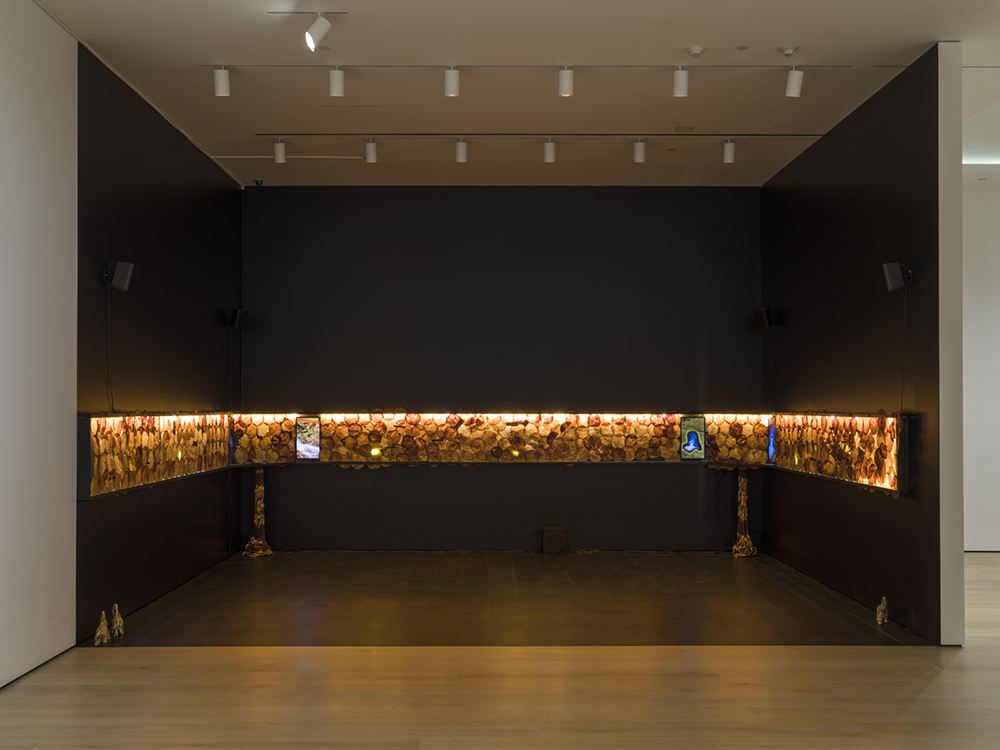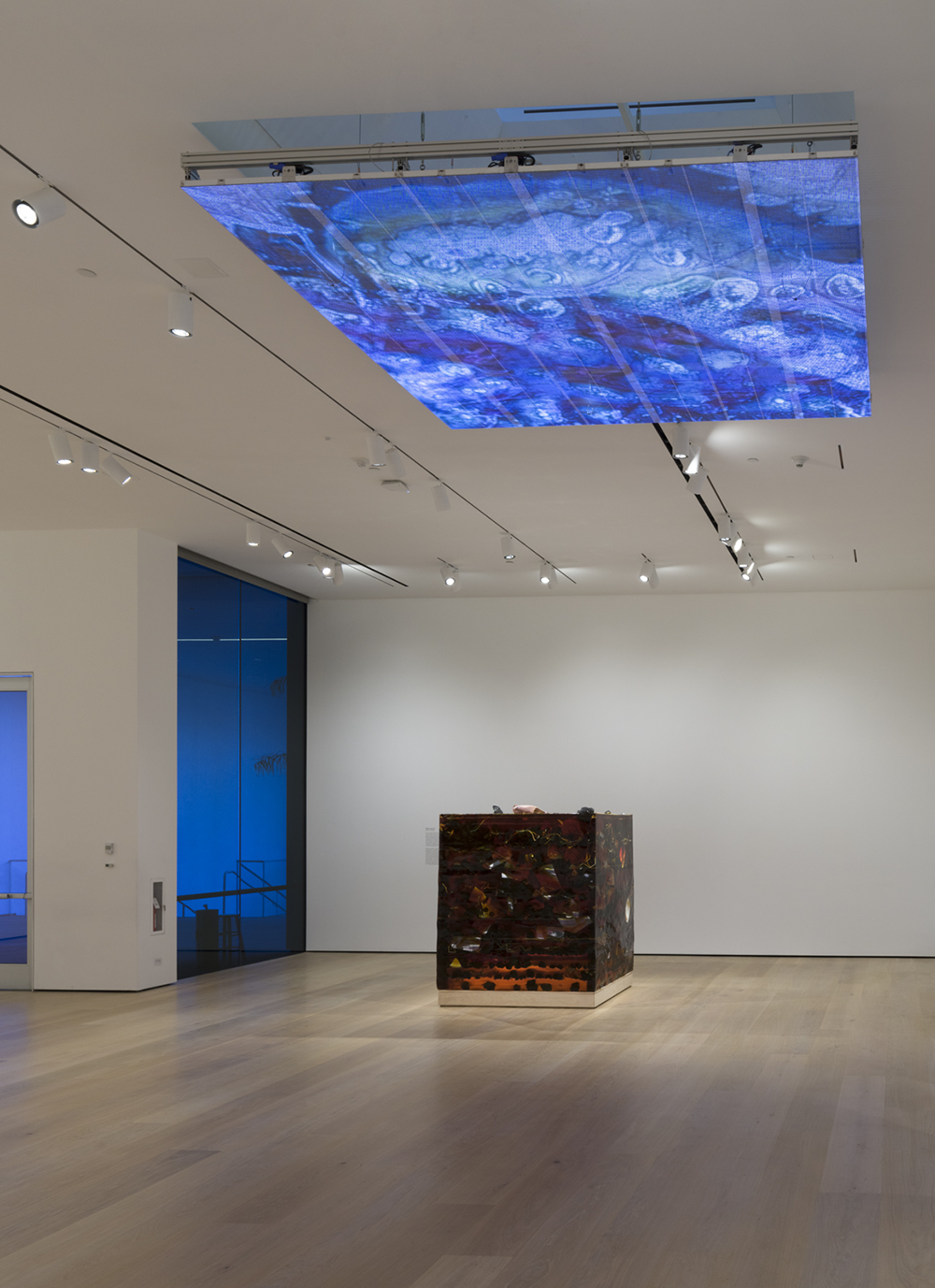The landmark exhibition “No Humans Involved” was remarkably compact, filling a single gallery at the Hammer with installations by only seven artists. Its impact, however, was seismic and sustained. Its title alone was enough to take viewers aback—and that was part of the point.
The term “N.H.I.” was first reported as appearing in internal Los Angeles Police Department communications, referring mostly to suspected street gang members, virtually all of them Black or Brown. Stanford literary philosopher and critic, Sylvia Wynter, seized upon this and events surrounding the 1992 LAPD beating of Rodney King to challenge what she regarded as its signal reflection of the implicitly racist linguistic and epistemological foundations of Enlightenment concepts of humanity.
The result was a sprawling 1992 epistolary essay challenging not merely conventional notions of humanity, but critical methodologies attached to art, culture and aesthetics. Curator Erin Christovale used this essay as the springboard for what is essentially a visual symposium to “interrogate and disrupt notions of what it means to be (hu)Man.” Whether it might “[offer] inklings of a future humanism that holds the potential for physical, cognitive and social liberation,” is slightly more fraught.
Certainly Wilmer Wilson IV’s 2017 Measures Not Men—a 7-foot wall of salt blocks like a blown-up frame of movable type inscribed on both sides—a “war memorial” in more than one sense—put paid to any simplistic reading of the notion, neutralizing the white-hot anger of its inscribed message (a letter sent to a Mississippi sheriff in the wake of a spate of lynchings of Black army veterans, promising to “burn the entire state” if it did not stop), yet literally rubbing salt into a wound that does not seem to close in our youthful “democratic experiment” of a republic.

“No Humans Involved,” installation view, Hammer Museum, Los Angeles, Photo: Jeff McLane.
Directly across, from Wilson’s wall/war of words, SANGREE, the collaborative partnership of Mexico City artists René Godínez-Pozas and Carlos Lara, countered with what almost seemed to pastiche the notion of a museum exhibition itself. Here, in this grouping of work from their Abiogenators series (playing on the notion that human life might have emerged out of a non-biological chemistry of clay, mud and earth), the artists constructed a semaphoric choreography of brilliant-hued vessels, masks and their connective supports—piers, pillars and pedestals in volcanic stone (cantera rosa).
That nonorganic construction was answered in turn by what from certain angles looked like a roiling sea of flesh—Sondra Perry’s large-scale mount of multiple lenticular panels, which proved to be exactly that, Flesh on Flesh (2021), a 3D image of the artist’s own facial skin surface morphed (via digital tools), into a super-magnified pigment-and-blood saturated terrain of pools and ridges, continuously refocused as the viewer moved from one end of the mount to the other, as if to foreshadow its ultimate transition into the stuff of earth and sea.
Before encountering any of these installations, though, the viewer was confronted with Eddie Aparicio’s monolithic cube of amber, Sepultura de semillas / Sepulchre of Seeds (2021), morphing and melting down through the duration of the exhibition; embedded with everything from fragmented steel and plastic car parts to organic detritus. At almost any angle, you could make out ceramic plates and cutlery, bits of fabric, straws and cigarettes, discarded commercial packaging—the detritus of a neighborhood, also its lifeblood. As both distillation and real-time decomposition of such notions, Aparicio perhaps came closest to the question framed in Christovale’s gloss of Wynter’s thesis: “How do you measure a life?”
No More Tears (2020), a luminescent jungle cavern constructed by siblings Mulowayi and Mapenzi Nonó, working collaboratively as Las Nietas de Nonó, seemed to most directly reference the trauma embodied in that dark police code, borne out of hunger (what might be walls of timber or stone looked like a patchwork of tortillas) and yearning for escape as if from desert islands (fantastical river rapids faded into view from inset digital screens; repeated on screens representing the Nonós’ formerly incarcerated cousins, the Salgado brothers and echoed in their “third eyes”).
WangShui’s overhead anamorphic video projection, Suspended Animation (or Scr…pe) (2021) with its blue boreal sea of protoplasm in undulant metamorphosis, inspired by Octavia E. Butler’s Xenogenesis trilogy, suggested that the imponderables of human life might only be answered by the equally imponderable alternative of an entirely transformed life form projected into the cosmos—effectively bringing the exhibition full circle; in short, that a future cognitively liberated ‘humanism’ might not be entirely human at all.


